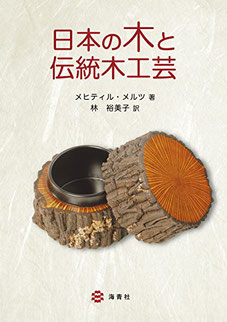English follows after Japanese below.
私は一昨年「木工藝―清雅を標に」(http://amzn.asia/5GCGvcC)を上梓しました。自らの作品と、日々の仕事の在り方を通して、日本の木工藝の歴史における自らの位置と今後の方向を明らかにしました。また私が今ある基礎として、日本木工小史を語りました。これはあくまで作り手、工藝家としての立場から執筆しましたが、同時にこの本の中で強調したのは研究者からの木工史、木工芸研究の必要性でした。豊富な樹種に恵まれた日本は古来木工が盛んで、高度な技を築き上げ現在まで連綿と伝えてきた国でありながら、一方でその学術的研究があまり行われていない事実を指摘しました。
そんな現状に一矢を報いる研究が一冊の本として出版されましたのでご紹介いたします。もともとは「Wood and Traditional woodworking in Japan」という英文の本でしたが、このたび翻訳され「日本の木と伝統木工芸」(http://www.kaiseisha-press.ne.jp/cat.pl?type=view&RecordID=1471929848)として海青社から刊行されました。待ちに待った和訳本です。著者のMertz氏はドイツで家具の製造を3年以上学び古家具の修復にも携わりました。その後研究の道に進みドイツ、フランス各地の大学で東アジア美術史、木材解剖学、民族植物学、などを修められました。木工の実技と理論、さらに素材としての木材にも精通している稀有な研究者です。氏が豊かな歴史を誇る日本の木工芸に関心を持ち、その豊富な知識を基礎に研究がなされたことは、我々日本の木工家にとって誠にうれしいことでした。
この研究は、世界の中で日本の木工芸を語るために、その基礎として日本の木材の世界標準の言葉、すなわち「学名」を明らかにすることから始まります。この点には私自身も常々気を付けており、自著の中でも可能な限り樹木に関して科学的でありたいと学名を併記し脚注も充実させたつもりです。Mertz氏はさらに堪能な語学を生かし、樹種名に関し標準和名、方言、俗名、学名を明らかにし、英語、仏語、そして独語に対応させています。巻末にあるこの樹種一覧は、技法の3か国語訳の表とともに画期的なことです。これで初めて世界中の研究者が同じ土俵で語れるようになりました。
さらに研究のハイライトは2年に及ぶ日本各地の木工家を訪ねての聞き取り調査を基にした、樹木、木材と製作者、製品、作品の関係についての相互作用の研究です。木工は自然素材である木材を相手にするため、千差万別の素材との取り組み方、素材への考え方における作り手ごとの違いが、たとえ同じ目的・形態のものを作っても違う製品・作品となってきます。しかし本研究は、その違いのなかに日本の木工芸の共通項を探そうとする試みであると言えます。「木を深く知り、木を生かす」ことこそ日本の木工芸の核心と見抜いた氏の眼力には敬服しますと共に私も深く同意します。素材への深い思いこそ、日本の木工家を木工家たらしめている核心でしょう。
加えて、いかに日本人のサポートがあったとはいえ、母国語でない言葉で聞き取った膨大な音声データをもとにした研究には頭が下がります。本来このような研究は第一義的には当事者たる日本の研究者によって行われているべき課題ですが、実際は今までこの分野の研究は皆無といっても過言ではないでしょう。これが私も指摘した日本の木工芸を取り巻く状況で本当に情けない思いです。
私は自著で自分という特殊を語ることによって日本の木工藝の一般を語る試みに取り組みましたが、Mertz氏は多くの作り手や木材関係者など文字通り「一般」の大海から共通項を引き出す遠大な研究を志向したように思えます。特にもともとは英語の本ですから、日本の木工・木工芸に関心のある世界中の愛好者、研究者の基礎テキストとなるものでしょう。
ただ各地の地域性を論点としながら、著者の拠点が京都大学のためか調査対象に関西方面が多いように思われるのが残念です。指物で東京が対象に入っていないのは、例えば焼き物で伊万里はあるが九谷がないようなもの。特に御蔵島桑と東京を中心とした近代木工芸の展開についての論及がないのはいかにも寂しい。また木工の生産様式を「伝統的工芸品の振興に関する法律=伝産法」に依拠する産業的側面にとどめず、美術工芸的側面への目配りがもう少し欲しかったといえるのではないでしょうか。現代にあっては経済的合理性の枠外にある美術工芸的取り組みの中にこそ、木と日本人の美意識の関係がはっきり出ているように思うからです。
総じて美学や工芸史などの人文科学・社会科学と、植物学などの自然科学の両者に通じたMertz氏ならではの研究であり、民族植物学的視点で書かれた、両者の橋渡しをする画期的な著作だと思います。日本の木工家も自らのよって立つ足許を確かめるためにもご一読を強くお勧めします。
Two years ago, I published"Japanese Fine Woodwork",on which book, there are two main themes. http://amzn.asia/5GCGvcC
First, through expressing my works and attitude toward daily working, my position and direction on the history of Japanese woodworking were clarified. Second, on the basis of what my work is, a short history of Japanese wood working was noted. Of course, my stance for publishing is that of one of fine wood workers, but at the same time, I emphasized the necessity for academic research of fine wood working: Moku-kougei itself and its history. Japan, which has various types of wood, has a long history of woodworking, fostered and handed high technique on the following generations. However, on the other hand, few types of academic research have been done.
One book breaking such a situation has been published ―“Wood and Traditional woodwork in Japan”http://www.kaiseisha-press.ne.jp/cat.pl?type=view&RecordID=1471929848. Originally it was published in English edition and has been republished in translated edition into Japanese by Kaiseisha press. The author is German researcher Dr.Mertz, who got apprenticed in Meister and passed the exam for it and later mastered art history of Eastern Asia, anatomy of wood material and ethnobotany. She is a quite excellent researcher to understand both technique and theory of wood working, and has deep knowledge of wood material. It's so pleasuring for us Japanese woodworkers that she got interested in Japanese woodworking with long history and this research has been done based on her deep knowledge.
This research begins with clarifying world standard name of woods; scientific name. In writing, always I also pay attention to this point and tried to do best for putting down bottom note in my book in order to be scientific toward wood material, but through her deep knowledge for various languages, she distinguishes wood names along standard Japanese name, dialect and popular name addition to scientific name into English, German and French. The list for materials and that about techniques in three languages are breakthrough to enable researchers in the world to discuss on the same stage.
The highlight of this research is about interaction between wood materials and products including products and works. Woodworking tackles natural materials, so even in making for the same purpose or in the same style, different works could be made, but just in that difference this research tries to discover traits common in Japanese fine woodwork. I admire and agree with her academic insight that found the essence of Japanese wood working is based on deep knowledge and efforts in utilizing the characteristics of wood, which means deep thought toward materials is core-value for making what Japanese fine wood workers are.
Furthermore, of course with supports of Japanese people, I take off my hats to the fact that this research is based on the huge audio data in non-native language toward her. Primary responsibility for such research should be assumed by researchers of its own country: Japan, but few ones have done, which is present miserable state surrounding today’s Japanese woodworking.
I tried to show what generality is in Japanese woodworking through expressing how my working is different from others, but on the other hand Dr.Mertz is oriented to far-reaching research to discover traits literally “common” to many wood workers and people involved with wood material. Especially, original edition was written in English, so it will serve as the basic textbook for enthusiasts and researchers interested in Japanese wood working.
However, the thing left to be desired is researching target is slightly dominated by
Western-Japan despite main theme is the uniqueness of each area, which may be because in Japan she is academically based on Kyoto-university. Especially it is incomplete that there is no mentioning about the development of modern wood working based on Tokyo and material mulberry coming out of Mikurajima-island: far South bound from Tokyo but the area of it. Addition to it, woodworking style should be noted not only from commercial aspects that based on The 'Law for the Promotion of Traditional Craft Industries' but from art and craft unique in Japan: Kögei. I think the relationship between wood and Japanese aesthetics is found not in commercially oriented attitude but in Kögei style.
In total, this book is amazing to be a bridge between cultural science like aesthetics and art history, and natural science like botany, which is of course from the author’s deep knowledge about both of those academic fields. To Japanese woodworkers, I recommend it so as to grasp where our working styles are on.


コメントをお書きください
Gabriel Waid (木曜日, 02 2月 2017 17:57)
Oh my goodness! Awesome article dude! Thanks, However I am encountering difficulties with your RSS. I don't know why I can't join it. Is there anyone else having the same RSS problems? Anyone who knows the answer can you kindly respond? Thanx!!
ディオール スーパー コピー (金曜日, 14 9月 2018 12:25)
ブランド 品 コピー http://www.pabrand.com/ 型押しされた光沢のあるレザーが知性と気品をプラスしてくれる伝統を重んじたクラシックな面影を残しつつ、かかとを抜いたスリッパタイプで軽快感溢れる絶妙なバランスが今にフィットしたハイブリットなアイテムになっています。ディオール スーパー コピー http://www.pabrand.com/brand-142.html